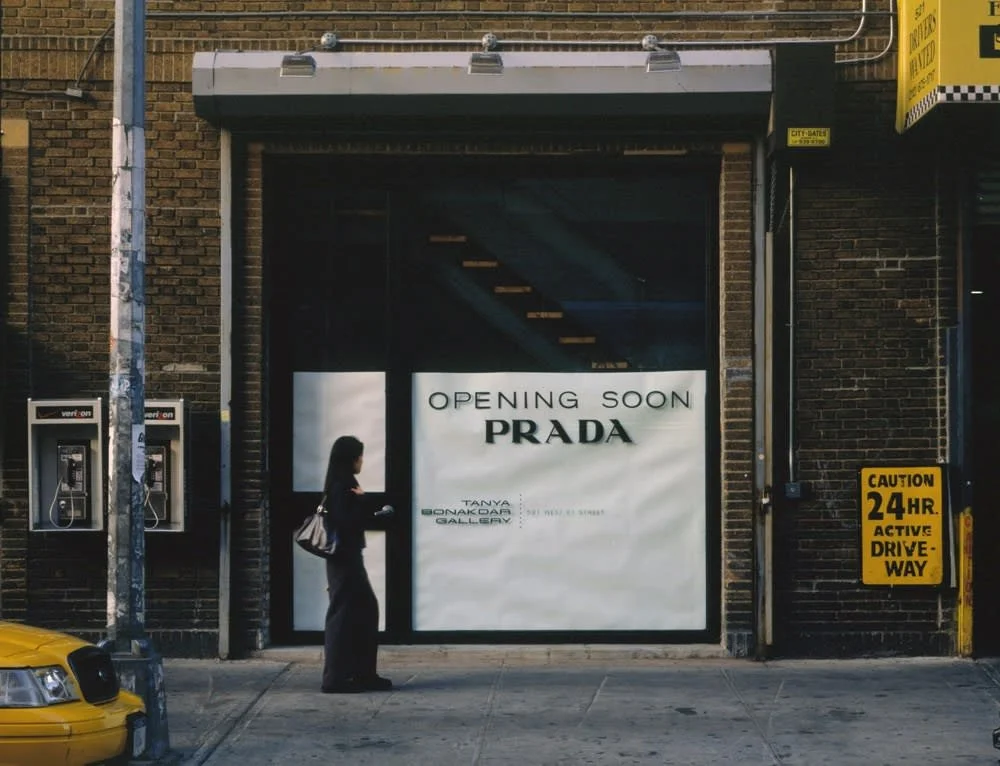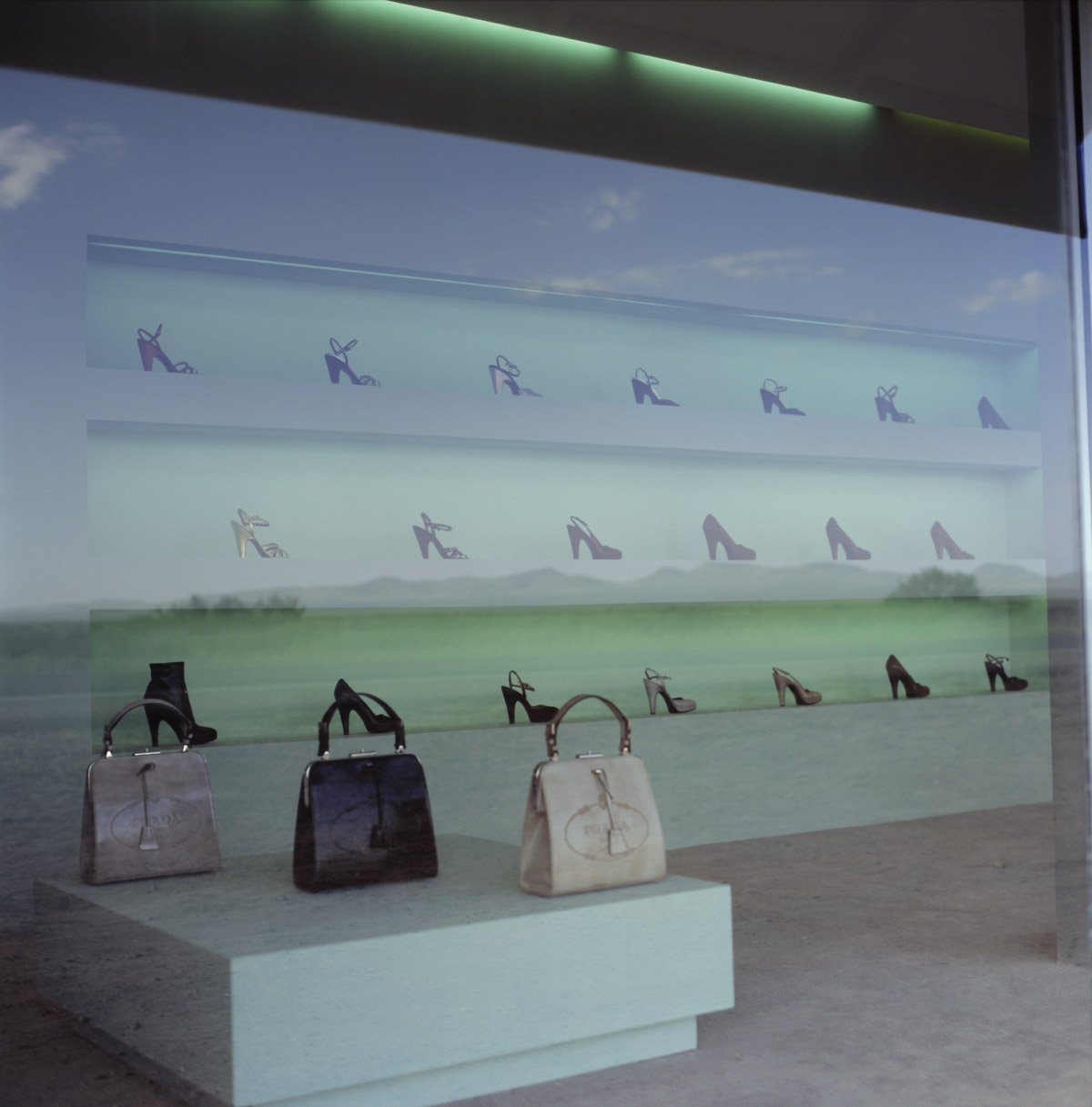PRADA MARFA
A piece of art in the middle of nowhere
The Prada Marfa project came to life on October 1, in 2005, conceived by artists Michael Elmgreen and Ingar Dragset and designed by architects Ronald Rael and Virginia San Fratello.
Designed as a real Prada boutique, the installation was commissioned by the Art Production Fund and the non-profit organization Ballroom Marfa. It is located in the middle of the Chihuahua Desert, Texas, about 60 km from the town of Marfa. The project was conceived by Elmgreen and Dragset as a denunciation of American consumerism and gentrification, imposing itself as an ironic provocation towards the materialism characteristic of the West. Moreover, in 2001, the two artists developed the precursor of the Texas installation in New York: they printed on a gallery window in Chelsea the words OPENING SOON, PRADA, leading many art collectors to believe that a real Prada boutique would open instead of the Tanya Bonakdar Gallery.
From Tanya Bonakdar Gallery website
The artwork was built with biodegradable materials, in particular with bricks made out of organic materials. The initial concept, in fact, was to build a structure that would naturally degrade over time, but this intention vanished very quickly. For their sculpture Elmgreen and Dragset drew inspiration from the minimalist style of the architect and designer Donald Judd. Inside the fake boutique, three shelves slide longitudinally, parallel to the glass panels.The shelves display twenty shoes, all size 37, with heels and all for the right foot.
The shelves display twenty shoes, all size 37, with heels and all for the right foot. Additionally, there are two small pedestals with three bags each.
The pistacchio green wall at the back, illuminated at night, is reflected in the darkness of the Texas road, almost reminescent of extraterrestrial lights, a fundamental part of local folklore.
At the very beginning, since the Prada Marfa project was meant to be temporary, the artists did not seek permission from the Milanese company to use their logo. Later, when the installation became permanent, Elmgreen and Dragset got in touch with the brand to ask for permission: at that point, not only did Miuccia Prada allow the use of the Prada logo but also personally curated the sculpture’s merchandise, providing bags and shoes from the FW05 collection. In addition to that, she gave information about the corporate design to be used to make the sculpture resemble a real Prada boutique as closely as possible.
Shortly after the official opening, the Prada Marfa project was vandalized. The Ballroom, the APF and the two artists decided to restore the sculpture because the vandalism occurred so prematurely that very few people had been able to see the work in its original state.
Prada donated six identical bags again, and the right-foot shoes were taken out of the boxes and displayed on the shelves. To prevent future theft, the bottoms of the bags were pitted.
Interior with 2005 line of bags and shoes , pic by James-Evans
However, in 2014, Prada Marfa was vandalized again. This time, both Elmgreen and Dragset reflected on the project’s evolving role. Actually, Elmgreen remarked: “When people interact with [public art], even vandalism can be seen as a positive – it’s a sign of people feeling that they have a say in public space.”
The last 14 years have unfolded with a series of unforeseeable events, including the advent of social media and Airbnb. In fact, when the sculpture was built, social platforms did not exist, nor did the selfie culture but time passing by and with the emergence of Instagram et similia, Prada Marfa turned into a major milestone for bloggers and celebrities worldwide. Thus, the artwork from a social denunciation became a consumerist act. The Prada Marfa phenomenon expanded further: road signs were printed for Prada Marfa as decorations for bedrooms, still popular among fashion lovers.
Until about fifty years ago, Marfa was a slowly declining rural community based mainly on livestock farming. However Donald Judd, considered to be one of the leading exponents of minimalism, moved there and soon began placing his installations, attracting significant attention, and so he founded, in 1986, the Chinati Foundation, a real open-air museum.
Consequently, due to Judd’s work and the Prada Marfa project, the town of Marfa experienced a strong increase in real estate, creating, despite the initial intentions, a real gentrification.
Marfa is a town with about 2,000 inhabitants, who have an average annual income of no more than 40,000 dollars. However, nowadays, finding houses below $500,000 has become impossible. As a result, although the tourism generated by the art installations and the Prada Marfa project has greatly helped the local economy, many historic residents struggle to live there.



